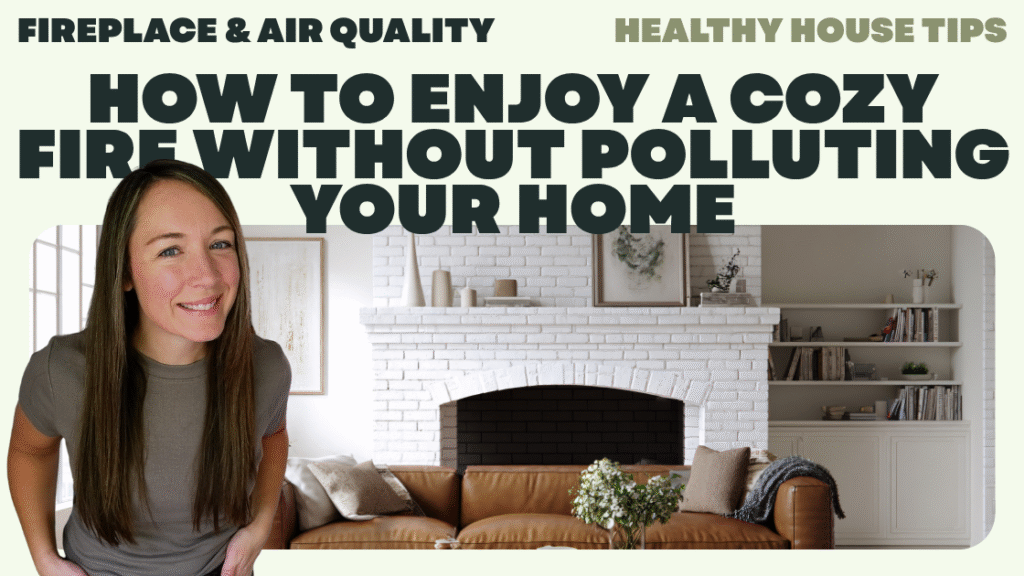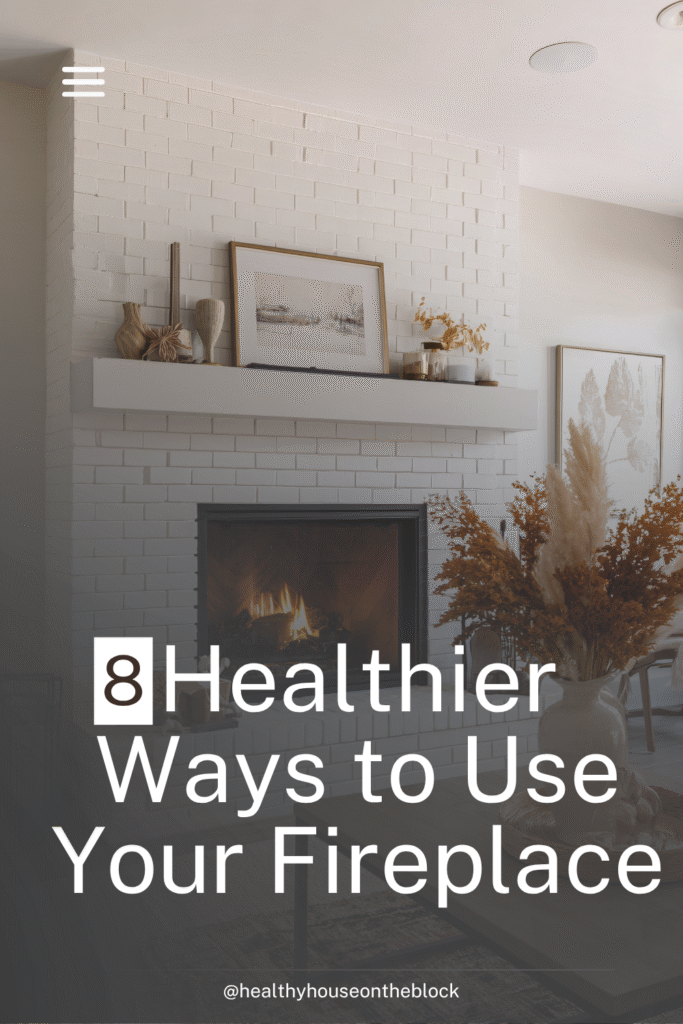
There’s something deeply comforting about a fire on a cold evening. The glow, the gentle crackle, the way it draws everyone into the same room. It’s one of those timeless rituals that makes a house feel like home.
But here’s what I want you to know: that same cozy fire can quietly fill your living space with pollutants you can’t see or smell. I’ve worked with so many homeowners who noticed headaches, sinus irritation, or worsening allergies every time they lit their fireplace. These symptoms often seemed unrelated until we started looking at the fireplace indoor air quality in their homes.
I’m sharing this not to take away the warmth or ambiance you love, but to help you understand how to enjoy your fireplace safely, in a way that truly supports your family’s health and wellness.
What You Need to Know About Fireplace Indoor Air Quality
The Hidden Impact of Wood Burning
When you burn wood or other solid fuel indoors, it releases a mix of pollutants into your home. These include fine particulate matter (PM₂.₅), carbon monoxide, nitrogen oxides, volatile organic compounds like formaldehyde and benzene, and polycyclic aromatic hydrocarbons.
Let me put this in perspective with some recent research. A 2025 study found that homes with open fireplaces had median indoor PM₂.₅ levels of around 38.4 µg/m³ during burning. To give you context, the EPA considers anything above 35 µg/m³ to be unhealthy for sensitive groups.
Even more concerning, a large U.S. study of over 50,000 women found that those using a wood burning fireplace or stove 30 or more days per year had a 68% higher rate of lung cancer compared to those who didn’t. This included women who had never smoked.
I share these facts not to alarm you, but to give you the full picture. When you understand what’s really happening, you can make informed choices that protect your family.
Why Fireplace Indoor Air Quality Spikes Matter
It’s not just about average pollutant levels. It’s about the spikes that happen throughout the evening. Research from the UK found that every time a wood burner door was opened to add more wood, particle concentrations surged to 3-4 times higher than baseline. Open fireplaces showed the highest risk.
The factors that make fireplace indoor air quality worse include:
- Small room size
- Low ventilation (less than 1.2 air changes per hour)
- Longer burning times
- Older fireplace models
A 2023 review found something that really stuck with me: using an open fireplace for just 4 hours a day during winter evenings could potentially shorten life expectancy by 1 to 1.6 years.

Why This Matters for Your Family
If you’re like most of the homeowners I work with, you’re doing everything you can to create a healthy space for your family. You’re reading labels, choosing better products, and making thoughtful decisions about what comes into your home.
Here’s why fireplace indoor air quality deserves the same attention:
Your family’s vulnerability: Children, older family members, and anyone with allergies or chemical sensitivities are more affected by particle and gas exposures. If someone in your home has asthma, cardiovascular issues, or immune challenges, fireplace use becomes even more important to manage carefully.
Modern, tight homes: If you’ve invested in good insulation and energy efficiency (which is wonderful), your home doesn’t “breathe” as much as older homes did. This means pollutants from your fireplace can linger instead of dissipating naturally.
Your hard work: You’re already putting in effort to reduce toxins in your home. An unmanaged fireplace can undercut all that work, adding avoidable exposures that affect your family’s health.

How to Use Your Fireplace Safely and Protect Indoor Air Quality
Personally, I love having a wood burning fireplace, but the nostolgia also comes with a bit more maintenance and work in order to enjoy it. Any home I’m inspecting gets a completely thorough i
The good news? You don’t have to give up your fireplace entirely. You just need to use it thoughtfully. Here are the practices I recommend, all grounded in research and real-world results.
Choose the Right Appliance
If you have an open masonry fireplace, this is your biggest opportunity for improvement. Open fireplaces tend to leak more smoke indoors and pull heated air out of your home.
Consider upgrading to a fireplace insert or EPA-certified wood stove. These closed combustion devices reduce emissions significantly and improve efficiency. Make sure whatever you use has proper venting, a tight firebox, and ideally a direct fresh air intake.
Use Only Clean, Dry Fuel
This is one of the simplest changes that makes the biggest difference in fireplace indoor air quality.
Burn only seasoned firewood that’s been cut and dried for at least 6 months. Dry wood produces less smoke and fewer VOCs.
Never burn painted, stained, treated, or engineered wood. Don’t burn garbage, plastics, or damp wood. These release additional toxins that you absolutely don’t want in your home’s air.
Build Hot, Efficient Fires
A hotter, cleaner fire produces fewer harmful byproducts. Cold, smoldering fires are much more polluting.
Avoid overloading your fireplace or letting it burn too low. A good, hot fire is actually better for your fireplace indoor air quality.
Ensure Proper Ventilation
This is critical and often overlooked. Your fire uses oxygen from your home’s air. Without fresh air coming in, you may actually pull polluted air back into your living space.
During burning, crack open a window on the opposite side of the room from your fireplace. If your fireplace has a fresh air duct to the firebox, make sure it’s open and functioning.
That same 2025 study I mentioned earlier found that homes keeping windows closed during burning had up to 3 times higher pollutant concentrations. A little fresh air makes a big difference.
Add an Air Purifier
This is one of my top recommendations for anyone who uses their fireplace regularly. Research shows that a quality air purifier can reduce indoor PM₂.₅ by 60-70% in homes with wood burning.
Choose a purifier with true HEPA filtration to capture fine and ultrafine particles. If you’re also concerned about VOCs, look for one with activated carbon filtration.
Place it in the same room as your fireplace or in the path where air circulates through your home. Run it during burning and for several hours afterward.
Burn Less Often and More Strategically
Every time you open your fireplace door, you risk a spike in indoor particles. Think about limiting your fires to special occasions rather than everyday use.
When you do burn, try to minimize how often you’re opening the door to adjust logs or add fuel.
Maintain Your Fireplace System
Dirty chimneys or blockages can cause smoke and particles to backdraft into your room instead of going up and out.
Have your chimney professionally cleaned annually. Clean out ashes regularly, disposing of them outdoors in a metal container. Check for any cracks, gaps, or poor sealing around your firebox and glass door.
Monitor Your Indoor Air
Consider investing in an indoor air quality monitor that tracks PM₂.₅, carbon monoxide, and ideally nitrogen dioxide. This lets you see exactly what’s happening in your home when you use your fireplace.
Knowledge is power. When you can see the data, you can make better decisions about how and when to use your fireplace.

When to Reconsider Your Fireplace
Sometimes the kindest thing I can do is help you see when something isn’t serving your health goals. You might want to reconsider regular fireplace use if:
- A family member has persistent respiratory issues, asthma, or chemical sensitivity
- Your home is very tightly sealed and lacks adequate ventilation capacity
- You can’t ensure that only dry, clean fuel is used
- You have an open masonry fireplace with significant air leakage
- You’re planning a remodel and want to prioritize the healthiest possible indoor air
- Someone in your home is experiencing symptoms that seem connected to fireplace use
In these situations, consider alternatives like a sealed, high-efficiency insert, an electric fireplace for ambiance, or creating a fireplace-free living space. Sometimes the healthiest choice is to use that space differently.

Moving Forward With Confidence
A fireplace can absolutely belong in a healthy home. But it needs to be managed thoughtfully, with the same care and attention you give to everything else that affects your family’s wellbeing.
You don’t have to choose between the comfort of a fire and your family’s health. You just need the right information and practices to have both.
I know that managing fireplace indoor air quality is just one piece of creating a healthier home. And if you’re feeling overwhelmed by all the information out there about toxins, or wondering where to even start, I want you to know something: it doesn’t have to be complicated.
You don’t need a perfect home to have a healthy home. You just need to focus your time and effort on the most important changes first.
That’s exactly what I cover in my free training, Your Health, Your Home: Creating a Healthier Space for Wellness. I’ll walk you through the simple framework I use to help families like yours reduce toxins without the overwhelm or guilt. Plus, you’ll get a workbook to help you take action right away.
Your home should support your health, not compromise it. And now you have the knowledge to make sure your fireplace does exactly that.

What’s your experience with fireplace indoor air quality? Have you noticed any symptoms when burning wood? I’d love to hear what questions you have in the comments below.
Share this:
- Click to share on Facebook (Opens in new window) Facebook
- Click to share on LinkedIn (Opens in new window) LinkedIn
- Click to share on Reddit (Opens in new window) Reddit
- Click to share on Pinterest (Opens in new window) Pinterest
- Click to print (Opens in new window) Print
- Click to share on X (Opens in new window) X



